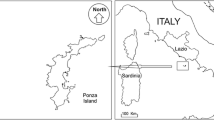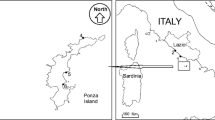Abstract
In order to test the aptitude of individuals of Mytilus chilensis as biomonitors of heavy metals pollution in seawater, several samples of this mollusk together with surrounding seawater samples were collected along 170 km of the coastal area of the Beagle Channel (Tierra del Fuego, Argentina) in 2005 and 2007. The study, performed in seven locations strategically selected, involved the determination of Cd, Cr, Cu, Ni, Pb and Zn in seawaters and mollusks by atomic absorption spectrometry (AAS) and the calculation of the respective concentration factors (CFs). Obtained data were standardized and analyzed by multivariate techniques in order to establish differences between sampling sites and periods. Obtained results will be shown and the bioaccumulation ability of M. chilensis will be evaluated by comparison with results obtained for Mytilus species in different geographical marine areas. A fully discussion on the possibility of employing the results as background levels for comparative purposes in other marine waters of the world will be provided. The possible harm derived from human consumption of these mollusks will be also assessed.






Similar content being viewed by others
References
Astorga España MS, Peña Méndez EM, Lecaros Palma O, García Montelongo FJ (1998) Heavy metals in Mytilus chilensis from the Strait of Magellan (Chile). Mar Pollut Bull 36:542–546
Astorga España MS, Rodríguez Rodríguez EM, Díaz Romero C (2004) Manganese, nickel, selenium and cadmium in molluscs from the Magellan Strait, Chile. Food Addit Contam 21:768–773
Astorga España MS, Rodríguez Rodríguez EM, Díaz Romero C (2005) Sodium, K, Ca, Mg, Fe, Cu and Zn concentrations in molluscs from the Magellan Strait (Chile): their contribution to dietary intake. Int J Food Sci Nutr 56:337–347
Astorga España MS, Rodríguez Rodríguez EM, Díaz Romero C (2007) Comparison of mineral and trace element concentrations in two molluscs from the Strait of Magellan (Chile). J Food Comp Anal 20:273–279
Bocca B, Conti ME, Pino A, Mattei D, Forte G, Alimonti A (2007) Simple, fast, and low-contamination microwave-assisted digestion procedures for the determination of chemical elements in biological and environmental matrices by sector field ICP-MS. Int J Environ Anal Chem 87:1111–1123
Boening DW (1999) An evaluation of bivalves as biomonitors of heavy metals pollution in marine waters. Environ Monit Assess 55:459–470
Boyle E (1988) Cadmium: chemical tracer of deepwater paleoceanography. Paleoceanography 3:471–489
Calabrese EJ, Canada AT, Sacco C (1985) Trace elements and public health. Annu Rev Publ Health 6:131–146
Campanella L, Conti ME, Cubadda F, Sucapane C (2001) Trace metals in seagrass, algae and molluscs from an uncontaminated area in the Mediterranean. Environ Pollut 111:117–126
Cantillo AY (1998) Comparison of results of Mussel Watch programs of the United States and France with Worldwide Mussel Watch studies. Mar Pollut Bull 36:712–717
Çevik U, Damla N, Kobya AI, Bulut VN, Duran C, Dalgic G, Bozaci R (2008) Assessment of metal element concentrations in mussel (M. galloprovincialis) in Eastern Black Sea, Turkey. J Hazard Mater 160:396–401
Chessel D, Dufour A, Thioulouse J (2004) The ADE4 package. I. One-table methods. RNews 4:5–10
Cheung MS, Wang WX (2008) Analyzing biomagnification of metals in different marine food webs using nitrogen isotopes. Mar Pollut Bull 56:2082–2105
Conti ME (ed) (2008) Biological monitoring: theory and applications. Bioindicators and biomarkers for environmental quality and human exposure assessment. The Sustainable World, 17. WIT Press, Southampton, UK
Conti ME, Cecchetti G (2003) A biomonitoring study: trace metals in algae and molluscs from Tyrrhenian coastal areas. Environ Res 93:99–112
Conti ME, Finoia MG (2010) Metals in molluscs and algae: a north–south Tyrrhenian Sea baseline. J Hazard Mater 181:388–392
Conti ME, Mecozzi M (2008) Multivariate approaches to biomonitoring studies. In: Conti ME (ed) Biological monitoring: theory and applications. The Sustainable World, 17. WIT Press, Southampton, UK, pp 213–226
Conti ME, Iacobucci M, Cecchetti G (2005) A statistical approach applied to trace metal data from biomonitoring studies. Int J Environ Pollut 23:29–41
Conti ME, Stripeikis J, Iacobucci M, Cucina D, Cecchetti G, Tudino MB (2006) Trace metals in molluscs from the Beagle Channel (Argentina): a preliminary study. WIT Trans Ecol Environ 99:473–483
Conti ME, Iacobucci M, Cecchetti G (2007a) A biomonitoring study: trace metals in seagrass, algae and molluscs in a marine reference ecosystem (Southern Tyrrhenian Sea). Int J Environ Pollut 29:308–332
Conti ME, Iacobucci M, Cucina D, Mecozzi M (2007b) Multivariate statistical methods applied to biomonitoring studies. Int J Environ Pollut 29:333–343
Conti ME, Iacobucci M, Cecchetti G, Alimonti A (2008) Influence of weight on the content of heavy metals in tissues of Mytilus galloprovincialis (Lamarck, 1819): a forecast model. Environ Monit Assess 141:27–34
Conti ME, Pino A, Botrè F, Bocca B, Alimonti A (2009) Lichen Usnea barbata as biomonitor of airborne elements deposition in the Province of Tierra del Fuego (southern Patagonia, Argentina). Ecotox Environ Saf 72:1082–1089
Conti ME, Bocca B, Iacobucci M, Finoia MG, Mecozzi M, Pino A, Alimonti A (2010) Baseline trace metals in seagrass, algae and molluscs in a southern Tyrrhenian ecosystem (Linosa Island, Sicily). Arch Environ Con Tox 58:79–95
Conti ME, Finoia MG, Bocca B, Mele G, Alimonti A, Pino A (2011) Atmospheric background trace elements deposition in Tierra del Fuego region (Patagonia, Argentina), using transplanted Usnea barbata lichens. Environ Monit Assess. doi: 10.1007/s10661-011-1985-y
Crisetig G, Cattani O, Viviani R (1984) Metalli tossici nei mitili dell’alto e medio adriatico. Arch Vet Ital 35:10–16
Deudero S, Box A, Tejada S, Tintoré J (2009) Stable isotopes and metal contamination in caged marine mussel Mytilus galloprovincialis. Mar Pollut Bull 58:1025–1031
Directive 2000/60/EC of the European Parliament and of the Council of 23 October 2000 establishing a framework for Community action in the field of water policy. Off J L. 327 of 22.12.2000
European Commission (2006) Commission Regulation No. 1881/2006 of 19 December 2006, Off J Eur Communities L 364/5, 2006
FAO/WHO (2002) Human vitamin and mineral requirements. Report of a Joint FAO/WHO Expert Consultation, Bangkok, Thailand 2002 FAO Rome, Italy
Food and Nutrition Board. The National Academies (2001) Dietary reference intakes for vitamin A, vitamin K, arsenic, boron, chromium, copper, iodine, iron, manganese, molybdenum, nickel, silicon, vanadium, and zinc. Available at: http://www.nap.edu/openbook.php?record_id=10026&page=44 (November, 5, 2010)
Giusti L, Zhang H (2002) Heavy metals and arsenic in sediments, mussels and marine water from Murano (Venice, Italy). Environ Geochem Health 24:47–65
Güell R, Aragay G, Fontàs C, Anticó E, Merkoçi A (2008) Sensitive and stable monitoring of lead and cadmium in seawater using screen-printed electrode and electrochemical stripping analysis. Anal Chim Acta 627:219–224
Kaimoussi A, Chafik A, Mouzdahir A, Bakkas S (2001) The impact of industrial pollution on the Jorf Lasfar coastal zone (Morocco, Atlantic Ocean): the mussel as an indicator of metal contamination. Comptes Rendus de l’Academie de Sciences—Serie IIa: Sciences de la Terre et des Planetes 333:337–341
Langston WJ, Spence SK (1995) Biological factors involved in metal concentration observed in aquatic organisms. In: Tessier ATD (ed) Metal speciation and bioavailability in aquatic systems. Wiley, Chichester, England, pp 407–478
Maanan M (2007) Biomonitoring of heavy metals using Mytilus galloprovincialis in Safi coastal waters, Morocco. Environ Toxicol 22:525–531
Martinčić D, Kwokal Z, Peharec Z, Margus D, Branica M (1992) Distribution of Zn, Pb, Cd and Cu between seawater and transplanted mussels (Mytilus galloprovincialis). Sci Total Environ 119:211–230
Muse JO, Carducci CN, Stripeikis JD, Tudino MB, Fernández FM (2006) A link between lead and cadmium kinetic speciation in seawater and accumulation by the green alga Ulva lactuca. Environ Pollut 141:126–130
Narin I, Soylak M (2003) The uses of 1-(2-pyridylazo) 2-naphtol (PAN) impregnated Ambersorb 563 resin on the solid phase extraction of traces heavy metal ions and their determinations by atomic absorption spectrometry. Talanta 60:215–221
Newell CR, Pilskaln CH, Robinson SM, MacDonald BA (2005) The contribution of marine snow to the particle food supply of the benthic suspension feeder, Mytilus edulis. J Exp Mar Biol Ecol 321:109–124
Newman MC, McIntosh AW (1982) Influence of lead in components of a fresh water ecosystem on molluscan tissue lead concentrations. Aquatic Toxicol 2:25–29
Özden O, Ulusoy S, Erkan N (2010) Study on the behavior of the trace metal and macro minerals in Mytilus galloprovincialis as a bioindicator species: the case of Marmara Sea, Turkey. J Verbr Lebensm 5:407–412
Phillips DJH (1976) Common mussel Mytilus edulis as an indicator of pollution by zinc, cadmium, lead and copper II. Relationship of metals in mussel to those discharged by industry. Mar Biol 38:71–80
Phillips DJH (1995) The chemistries and environmental fates of trace metals and organochlorines in aquatic ecosystems. Mar Pollut Bull 31:193–200
Price NM, Morel FMM (1990) Cadmium and cobalt substitution for zinc in a marine diatom. Nature 344:658–660
Rainbow PS, Phillips DJH (1993) Cosmopolitan biomonitors of trace metals. Mar Pollut Bull 26:593–601
Reilly C (1991) Metal contamination of food, 2nd edn. Elsevier Applied Science, London
Saavedra Y, Gonzalez A, Fernandez P, Blanco J (2004) The effect of size on trace metal levels in raft cultivated mussels (Mytilus galloprovincialis). Sci Total Environ 318:115–124
Süren E, Yilmaz S, Türcoglu M, Kaya S (2007) Concentrations of cadmium and lead heavy metals in Dardanelles seawater. Environ Monit Assess 125:91–98
Szefer P, Kim B-S, Kim C-K, Kim E-H, Lee C-B (2004) Distribution and coassociations of trace elements in soft tissue and byssus of Mytilus galloprovincialis relative to the surrounding seawater and suspended matter of the southern part of the Korean Peninsula. Environ Pollut 129:209–228
Takesue R, Van Geen A, Carriquiry J, Ortiz E, Godinez-Orta L, Granados I, Saldívar M, Ortlieb L, Escribano R, Guzmán N, Castilla J, Varas M, Salamanca M, Figueroa C (2004) Influence of coastal upwelling and El Niño-Southern Oscillation on nearshore water along Baja California and Chile: shore-based monitoring during 1997–2000. J Geophys Res 109:1–14
Tapia J, Vargas-Chacoff L, Bertrán C, Carrasco G, Torres F, Pinto R, Urzúa S, Valderrama A, Letelier L (2010) Study of the content of cadmium, chromium and lead in bivalve molluscs of the Pacific Ocean (Maule Region, Chile). Food Chem 121:666–671
Turner A, Pedroso SS, Brown MT (2008) Influence of salinity and humic substances on the uptake of trace metals by the marine macroalga, Ulva lactuca: experimental observations and modeling using WHAM. Mar Chem 110:176–184
USFDA, Food and Drug Administration (1993a) Guidance Document for Cadmium in Shellfish. US Department of Health and Human Services, Public Health Service (p. 44), Office of Seafood (HFS-416), 200 C Street, SW, Washington, DC. 20204, 1993a
USFDA, Food and Drug Administration (1993b) Guidance Document for Chromium in Shellfish. US Department of Health and Human Services, Public Health Service (p. 40), Office of Seafood (HFS-416), 200 C Street, SW, Washington, DC. 20204, 1993b
USFDA, Food and Drug Administration (1993c) Guidance Document for Lead in Shellfish. US Department of Health and Human Services, Public Health Service (p. 45), Office of Seafood (HFS-416), 200 C Street, SW, Washington, DC. 20204, 1993c
Valdés J, Román D, Dávila P, Ortlieb L, Guíñez M (2006) Seasonal variability of cadmium in a coastal upwelling system off northern Chile (Mejillones Bay, 23° S). Rev Chil Hist Nat 79:517–535
Van Geen A, Husby D (1996) Cadmium in the California current system: tracer of the past and present upwelling. J Geophys Res 101:3489–3507
WHO/FAO (1993) Summary report of the 41st meeting of the joint FAO/WHO expert committee on food additives (JECFA). FAO, Roma 1993
WHO/FAO (1999) Summary report of the 53rd meeting of the joint FAO/WHO expert committee on food additives (JECFA). FAO, Roma 1999
Zhou F, Guo H, Hao Z (2007) Spatial distribution of heavy metals in Hong Kong’s marine sediments and their human impacts: a GIS based chemometric approach. Mar Pollut Bull 54:1372–1378
Acknowledgments
We are grateful to Javier Omar Giordano and his team for their support during our stays in Tierra del Fuego. This work was in part financially supported by project of the Consorzio Universitario Italia-Argentina (CUIA-2006)—‘Biological monitoring of the Beagle Channel (Patagonia, Argentina)’. This work was also financially supported by project prot. C26F09TP2K-2009, Sapienza, Università di Roma, Italy.
Author information
Authors and Affiliations
Corresponding author
Rights and permissions
About this article
Cite this article
Conti, M.E., Stripeikis, J., Finoia, M.G. et al. Baseline trace metals in bivalve molluscs from the Beagle Channel, Patagonia (Argentina). Ecotoxicology 20, 1341–1353 (2011). https://doi.org/10.1007/s10646-011-0690-5
Accepted:
Published:
Issue Date:
DOI: https://doi.org/10.1007/s10646-011-0690-5




